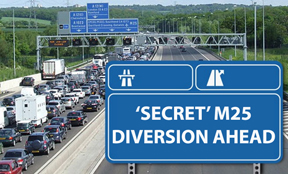
Motorist have many signs and road markings to deal with, but while most are well-known and understood, double white lines in the road can still cause a dangerous sense of confusion among many some drivers using UK roads.
Here we look at what double white lines mean and how motorists should driver when they encounter them on the road.
 What
do double white lines like these actually mean? And how they could get you a £1,000 fine (Credit: As
stated on image)
What
do double white lines like these actually mean? And how they could get you a £1,000 fine (Credit: As
stated on image)
What are double white lines?
There are two main types of double white lines that motorists are likely to come across when out driving on the road. The two types are as follows.
Double white lines with one solid line and one broken line: This type of double white line means you can overtake – when it is safe to do so – if the broken white line is on your side of the road. You must complete the overtake before reaching any section of solid double white lines in the centre of the road – look out for arrows on the road telling you to get back on your side of the road.
Vehicles travelling on the other side of the road, with the solid white line closest to them, must not overtake while the line persists. There are some exemptions to this rule, which we explain further
Double white lines that are both solid: These lines mean that you should remain in your line and not overtake throughout their duration. However, as mentioned above, there are occasions when you can cross the solid white lines and move onto the other lane. See further down the page for information.
When can you cross a solid double white line in the road?
While double white lines in hr middle of the road mean that vehicles cannot cross into the adjacent lane when one or both are solid, there are circumstances when this rule does not apply.
Drivers may cross double white lines, when the one on their side of the road, or both, are solid if passing a stationary vehicle, or overtaking a pedal cycle, horse or road maintenance vehicle that is travelling at less than 10mph. Drivers can also cross the lines if they are turning into a property or side road when it is safe to do so.
As mentioned previously, motorists can also cross when the white line closest to them is broken, when safe to do so.
What does the Highway Code say about double white lines?
Section 129 the Highway Code says the following with regard to white lines.
Double white lines where the line nearest you is solid.
This means you MUST NOT cross or straddle it unless it is safe and you need to enter adjoining premises or a side road.
You may cross the line if necessary, provided the road is clear, to pass a stationary vehicle, or overtake a pedal cycle, horse or road maintenance vehicle, if they are travelling at 10 mph (16 km/h) or less.
Section 128 the Highway Code says:
Double white lines where the line nearest to you is broken.
This means you may cross the lines to overtake if it is safe, provided you can complete the manoeuvre before reaching a solid white line on your side.
At-a-glance guide to double white lines
Type of double white line |
What it means? |
When can I cross the white lines? |
| Broken white line closest to you, and solid white line on opposite side | If the broken white line is on your side, you may overtake | When it is safe to do so |
| Solid white line closest to you, and broken white line and solid broken line on opposite side | You may not cross the white line unless for reasons stated, right | You may cross the solid white lines to overtake a stationary vehicle, or overtake a pedal cycle, horse or road maintenance vehicle travelling at less than 10mph. You may also do so if turning into a property or side road when it is safe to do so |
| Double solid line | You must not cross the double white lines unless for reasons stated, right | You may cross the solid white lines to overtake a stationary vehicle or one travelling at less than 10mph. You may also do so if turning into a property or side road when it is safe to do so |
Most read motoring content
Take a look at more of our top motoring-related content here...
-
How much is my car tax going to go up by this year?
-
My driving licence has expired - can I keep driving while I wait for a new one?
-
Secret parking offences you're committing but don't realise
-
Are my sunglasses legal for driving - how to check instantly?
-
How old is a car by its number plate? Full list
-
Will I always get a speeding ticket after being flashed
-
Will I get a speed awareness course instead of points?
-
Do I need an international driving permit for France, Spain, Greece and other EU countries
-
Do I pay the Birmingham Clean Air Zone at weekends?
-
What does my driving licence number reveal about me - and why it should never be shared online
-
How to spot a fake undercover police car
-
Do I need an electric car licence and driving test in the UK?
-
Can I vape in a car with kids in it?
-
Can I book cancelled driving tests to beat the rush?
-
When can I apply for a provisional licence?
-
Are electric scooters legal in the UK now? When is the law changing?
-
Can I drive in sliders in the UK?
-
What are the black dots on my windscreen for?
-
How can I find out who owns a car
-
Electric car charging points at UK airports for public use - 2022
-
How old are my tyres - find out instantly here
-
What happens to a car when the owner dies?
-
How far and how fast can I drive on a space saver spare wheel
-
Can I be fined if the car park ticket machine is not working?
-
Is the M6 Toll Road free in the evening and at weekends?
-
How much is the Tamar Bridge toll and when do I need to pay it?
Subscribe for free motoring and travel news from PeteBarden.co.uk
Author: Pete Barden:
Twitter: @pete_barden
Pete Barden is a qualified journalist who has written and produced for publications including The Sun (thesun.co.uk), New Statesman Media Group, Whatcar? (Whatcar.com) Stuff Magazine (Stuff.tv), Fastcar Magazine (Fastcar.co.uk), Maxim Magazine and UK broadcast stations within the Heart network (Formerly GCAP). Pete specialises in motoring and travel content, along with news and production roles. You can find out more about Pete Barden on LinkedIn.
Read all articles by Pete Barden











